2 Irrigation
The irrigation system on a golf course is critical for the maintenance of high-quality playing conditions. Throughout Virginia, various types of irrigation systems are used, ranging from basic quick connect and hose applications to advanced multi-row sprinkler systems. Advanced systems conserve water, making use of the latest in computerized central control, state-of-the-art pumping systems, sprinklers with highly efficient nozzles, soil sensors, radio communication, and weather data collection devices.
Because every golf course is different, the requirements, design, and specifications of irrigation systems differ. Therefore, irrigation recommendations should be adapted to fit the needs of a particular system and serve as a basis for determining the course-specific water conservation methods. Furthermore, using BMPs for all facets of design, construction, and maintenance operations aids in the overall conservation of water resources and quality.
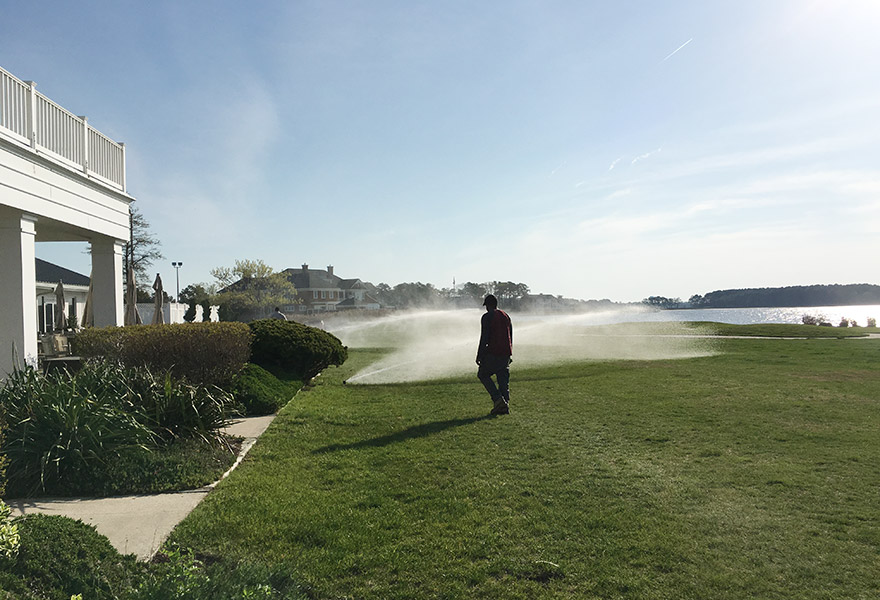
2.1 Regulatory Considerations
Virginia DEQ regulates water usage in Virginia, as described below. When municipal or public potable water sources are used as a primary or secondary water source for irrigation, local governments regulate cross connection to prevent backflow.
2.1.1 Surface Water
Under the Virginia Water Protection Permit Program Regulation (9VAC 25-210), surface water withdrawals require a permit. The DEQ Surface Water Withdrawal Permitting and Fees web page provides more information on permits, including forms and checklists.
2.1.2 Groundwater
Under the Ground Water Management Act of 1992, Virginia manages groundwater through a program regulating the withdrawals in certain areas called Ground Water Management Areas (GWMA). Currently, two GWMAs exist in the state within the Coastal Plain province of Virginia: the Eastern Shore GWMA, which includes Accomack and Northampton counties, and the Eastern Virginia GWMA, which is comprised of all areas east of I-95. Any person or entity wishing to withdraw an excess of 300,000 gallons in a single month in a GWMA must obtain a groundwater withdrawal permit. The DEQ Groundwater Withdrawal Permitting and Fees web page provides more information, including permit forms and information on new well construction requirements.
2.1.3 Water Withdrawal Reporting Requirements
Virginia Water Withdrawal Reporting Requirements (9 VAC 25-200-10, et seq.) require reporting for any withdrawal with a daily average withdrawal that exceed 10,000 gallons in any single month. Each withdrawer must report to DEQ the surface water or groundwater withdrawals by January 31 in the year following the one in which the withdrawals occurred.
2.2 Water Conservation and Efficient Use Planning
Potable water supplies in many areas of the United States are limited, and demand continues to grow. The challenge is to find solutions to maintain the quality of golf play while using less water. Opportunities to conserve water exist during initial course design and renovations, during irrigation system design and use, and by incorporating the use of management zones.
Some courses are designed using a “target golf” concept that minimizes the acreage of irrigated turf. If properly designed, water hazards and stormwater ponds can capture rain and runoff that may provide supplemental water under normal conditions. Backup sources may be needed during severe drought.
In addition to utilizing well-adapted cultivars for in-play areas, existing golf courses can convert out-of-play area turf to native plants, grasses, or ground covers to reduce water use and augment the site’s aesthetic appeal. Native plant species also provide wildlife with habitat and food sources, such as native flower areas that benefit pollinators. After establishment, site-appropriate plants normally require little to no irrigation. See the “Pollinator Protection” and “Landscape” chapters for more information on native and drought-tolerant plants.
Water conservation plans should be prepared before a drought occurs, especially in the drier parts of the state. These plans should identify ways to achieve a 10% reduction in water use. Current drought reporting information is made available online for Virginia on DEQ’s Current Drought Conditions in Virginia web page. Communication with golf club members and the public should be maintained to explain water conservation efforts as a proactive approach to addressing water-related issues.
2.3 Drought Resistance
Some of the areas of the golf course may be irrigated sparingly or not at all. Planning for these areas and restricting their irrigation requires knowledge of the most drought-resistant turfgrass species (Figures 3-9 and 3-10 from 1st edition; TBA) and maximizing this resistance. Drought resistance encompasses two facets: avoidance and tolerance. Drought avoidance is preferred, since it is the ability to stay green and growing as surface soil dries and drought progresses. Drought tolerance is the ability to keep growing points alive, though not necessarily green, as drought progresses.
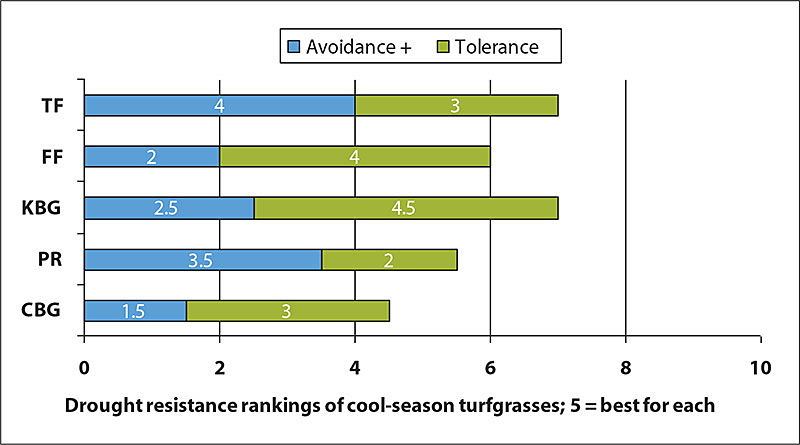
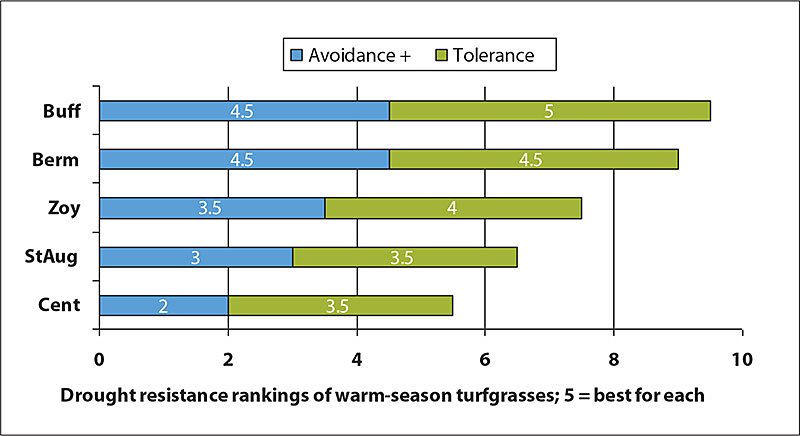
2.4 Irrigation Water Supply
2.4.1 Irrigation Water Sources
Golf course designers and managers should identify and use alternative water supply sources to conserve freshwater drinking supplies whenever possible. The routine use of potable water is not a preferred practice. Municipal drinking water should be considered only when no alternatives exist.
2.4.2 Irrigation Water Quality
Water should be assessed to determine its suitability for irrigation and for plant growth. Non-potable water irrigation sources (such as retention ponds and recycled water) should be regularly tested to ensure that the quality is within acceptable parameters for irrigation. Commercial laboratories can analyze water samples and makes recommendations based on the electrical conductivity (EC) and sodium adsorption ratio (SAR) determined on the irrigation water and the soil series present on the land. The assessment identifies the chemical characteristics of the water and can be used to address possible issues with soil salinity and plant health caused by poor water quality.
For more information see:
- Irrigation Water Quality Guidelines for Turfgrass Sites, Penn State University.
- “Understanding Water Quality and Guidelines to Management,” USGA Green Section Record.
2.4.3 Irrigation Water Requirements
An adequate water supply is essential for any planned or proposed golf course irrigation system. Water requirement analyses can be conducted to understand irrigation needs. A seasonal bulk water requirement analysis verifies the suitability of a water source and irrigation system to supply irrigation water under normal conditions. Because of the potential for drought, a maximum seasonal bulk water requirement analysis should be conducted as a worst-case scenario and calculated to not account for rainfall. For more information on calculating water requirements and example calculations, see Chapter 3 of the 1st edition of Environmental Best Management Practices for Virginia’s Golf Courses.
It is essential that all delivery systems install and maintain accurate metering devices. Being able to measure water use allows baselines to be established and progress in water conservation efforts to be tracked. Installation of water meters will become more critical as more regulatory and compliance obligations are imposed on water for irrigation.
2.5 Irrigation System Design
2.5.1 Site Assessment
Collecting accurate site data is critical to the irrigation design process. A wide number of site-specific conditions affect the planning and efficiency of an irrigation system. During this preliminary planning stage, the golf course superintendent should seek assistance from Certified Golf Course Irrigation System designers, professional irrigation consultants, and professionals certified through WaterSense programs
In addition to assessing the site’s physical characteristics (such as water sources, soil types, soil physical properties, microclimates, slopes, and sun, wind and shade exposures), the site assessment should also evaluate the impact of design elements, such as design features and concepts, planned or existing turfgrass varieties, and planned or existing drainage systems. The system design should include a general irrigation schedule with recommendations and instructions on modifying the schedule to meet these site-specific needs.
2.5.2 Design
Irrigation systems should be designed to be efficient, distribute water uniformly, conserve and protect water resources, and meet state and local code and site requirements. Site specific characteristics and incorporation of water conservation practices and technologies should be evaluated in the design.
A well-designed irrigation system should operate at peak efficiency and be designed and installed to optimize water use effectively, focusing on water placement and distribution. The design should maximize water use, reduce operational cost, conserve supply, and protect water resources. Where feasible, variable frequency drive (VFD) pumps and/or pump stations should be used. These systems only expend enough energy to meet the demands of the irrigation pump(s). VFD systems reduce water hammer to fitting, pipe, and sprinklers when systems are pressurized.
Detailed BMPs for irrigation system design are published by the Irrigation Association in 2014 Landscape Irrigation Best Management Practices.
Design Considerations
The irrigation system design should meet the site-specific needs identified by the water quantity analyses and the site assessment. The system’s capacity to deliver water should not exceed the infiltration of the soils, as that will lead to runoff. Though the design of an irrigation system is complex, some of the most important design decisions that influence the efficiency and effectiveness of water usage include those related to sprinkler and piping placement, sprinkler coverage and spacing (Table 2), and communication options.
Table 2. Sprinkler coverage and spacing considerations
| Sprinkler Spacing | Advantages/Disadvantages |
|---|---|
| Manual and/or single row sprinkler coverage Typically use long radius sprinkler spacing > 90 ft. |
Scheduling coefficient values are high and distribution uniformity values low. Overall, this type of fairway coverage results in inefficient irrigation. |
| Double row sprinkler coverage Sprinkler throw distances range from 80 to 90 ft., increasing the effective width of coverage and allowing for individual sprinkler control based on the terrain of the fairway area. |
Offers an improvement in efficiency over single row coverage. However, manual hand watering or other types of supplemental watering may be needed outside the fairway area and into the extended rough. |
| Multi-row sprinkler coverage Incorporates three to five rows. Typically, the spacing of sprinklers ranges from 55 to 75 ft. |
Offers the best method to control and conserve water and provides the user the best ability to respond to specific moisture requirements of a given fairway area. |
Sprinkler layouts can be specific to each area. For example, part-circle sprinklers can be arranged to avoid overspray of impervious surfaces and to apply water only to the green surface or in heavy traffic areas. Manual quick-coupler valves can be an important conservation element and should be installed near greens, tees, and bunkers so these can be hand-watered during severe droughts. Irrigation systems strive to provide uniform water distribution and to achieve distribution uniformity (DU) values near 80%. After installation, nozzles and irrigation head runtimes should be optimized to maintain uniform soil moisture distribution. That can be easily monitored with a soil moisture probe.
Precision Irrigation Control
For precise irrigation control, courses should consider using advanced irrigation control systems that can schedule each green, tee, and fairway separately and allow course managers to adjust for differences in microclimates and root zones. Weather stations that calculate and automatically program water replacement schedules also provide opportunities for more precise irrigation, as do soil moisture sensors placed in multiple locations. Additional water conservation features may include such things as single head control and rain stop safety switches that either shut down the system in the event of rain or adjust schedules based on the amount of precipitation.
2.6 Irrigation Pumping Stations
Irrigation pumping systems play a key role in water management and life cycle management of any irrigation system. Modern pumping systems are complex arrangements of hydraulics, electronics, and communications that keep water flowing at specific rates and pressures. Properly designed and maintained, these systems can assure the user of quality service and production. Poorly designed and maintained pump systems can increase maintenance costs, create service issues, and waste energy and water. The most commonly used pump type for golf course irrigation is the vertical turbine configuration, which offers greater efficiency, less overall maintenance, and fewer loss-of-suction issues than other pump types. Major system components include a pump station, irrigation pumping station control, and intake and discharge piping networks.
Irrigation pumping system control can best be achieved by programmable logic controllers (PLC) in conjunction with VFD to efficiently determine the proper speed of the pump motor based on demand. Hydraulic system pressures can also ramp up and down relative to system flows to ensure the piping network is not compromised. These systems provide advantages over regulating valves and limit switches, which do not vary based on demand and produce non-uniform pressure strain on the piping network. Computerized irrigation central control systems and PLC also allow remote monitoring of the operation of the pump station. Pump station control software that integrates with the irrigation central control software allows remote monitoring of pump station operation and provides water use and consumption data.
2.7 Irrigation System Installation
To ensure maximum efficiency, the irrigation system must be installed per the design and specifications. The installer must ensure that there is qualified supervision of the installation process and that a qualified irrigation specialist inspects and approves the system installation.
2.8 Irrigation System Maintenance and Performance
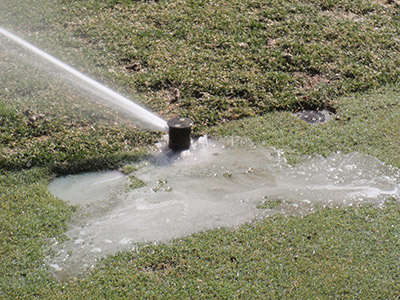
A properly working irrigation system is critical to ensure optimum operation. System checks and routine maintenance should be done for pumps, valves, programs, fittings, and sprinklers. A schedule of inspections and a plan for record keeping should be completed. Use of photography is especially helpful in recording installations/repairs of underground systems. The publication 2014 Landscape Irrigation Best Management Practices can be consulted for devising a schedule and a plan for record keeping.
To ensure that it is performing as intended, an irrigation system should be calibrated regularly by conducting periodic irrigation audits, such as catch-can tests and an annual irrigation audit, to check actual water delivery and nozzle efficiency. Nozzles can wear over time. This will change irrigation output and distribution. Nozzles should be replaced, depending on the manufacturer’s recommendation, to ensure proper function. Inspecting and exercising isolation valves ensures their sound operation in the event of an irrigation break.
While routine inspection and audits can be performed by the golf course superintendent, a professional irrigation consultant is required for a detailed irrigation audit, which should be conducted according to the Irrigation Audit Guidelines published by the Irrigation Association. Ideally, this professional audit should be conducted at least once every five years.
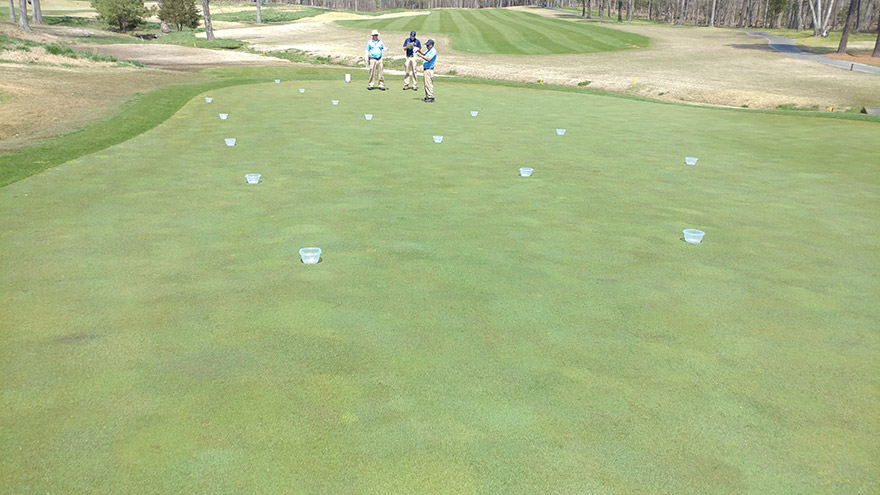
2.8.1 Winterization
Winterizing protects irrigation system pipes from damage due to water expanding and rupturing the pipe walls and fittings. Golf courses need to drain or use compressed air to remove water from lateral and mainlines pipes, sprinkler heads, and quick couplers before temperatures drop below freezing.
2.8.2 Spring Start-up
Spring start-up of the irrigation system is essentially the reverse of the steps taken to winterize the system. At the time of start-up, the system should be inspected for corrective maintenance issues.
2.9 Irrigation Management Decisions
An irrigation system should be operated based only on the moisture needs of the turfgrass – or to water-in a fertilizer or chemical application as directed by the label – not on a calendar-based schedule.
The principle of “deep and infrequent” delivery of water promotes deep rooting, gas exchange, and soil temperature moderation, while discouraging surface soil compaction. Enhanced soil gas exchange also promotes increased rooting density, improving water and nutrient absorption efficiency. In practice, for unobstructed soils of 12-18” in depth, the irrigation system applies water to fill soil pores to the depth of roots and then does not irrigate again until surface soil moisture has been depleted to near the wilting point. Soil type, effective root zone depth, and estimated ET demand determine irrigation frequency and soak cycle needs. Turfgrass species also affects irrigation frequency, since some turfgrasses more effectively resist drought than others.
2.9.1 Soil Infiltration Rate and Plant Available Water
Sandy soils, with their higher porosity, have greater infiltration rates (2-20” per hour) than silty or clay soils (0.25–1” per hour). Soil type also determines how much water per inch can be held at field capacity. Soil compaction restricts permeability but can be enhanced with regular core aerification.
Plant available water (PAW) represents the amount of water (expressed in inches) available per inch of soil depth that a plant can access for transpiration. A soil moisture probe indicates the total volumetric water content, which is greater than the PAW for a soil. The PAW can be estimated with a soil moisture meter by subtracting the current soil moisture content from the moisture content when the turf wilts. Plant available soil moisture and infiltration rates are provided in Table 3.
Table 3. Available soil moisture and infiltration rates for common soil textures
| Soil Texture | Soil Type | Typical plant-available moisture per foot of soil depth (inches) |
Infiltration rate (inches h-1) |
|---|---|---|---|
| Light, sandy | Coarse sand Fine sand |
0.25 – 0.75 0.75 – 1.00 |
Fast (0.5 – 6+) |
| Medium, loamy | Loamy sand Sandy loam Fine sandy loam Silt loam |
1.10 – 1.20 1.25 – 1.40 1.50 – 2.00 2.00 – 2.50 |
Moderate (0.25 – 0.5) |
| Heavy, clay | Silty clay loam Silty clay Clay |
1.80 – 2.00 1.50 – 1.70 1.20 – 1.50 |
Slow (0.1 – 0.25) |
2.9.2 Effective Root Zone Depth
Effective root zone depth is defined as the depth to which 90% of the root system penetrates and must be determined onsite with a soil probe or spade. The soil type and effective root zone depth together are used to estimate the soil water-holding reservoir available to the root system.
2.9.3 Evapotranspiration
ET is a combination of the transpirational water needs of the plant and water lost from the soil surface via evaporation. As temperatures increase and the relative humidity decreases, ET demand rises. ET requirements vary based on turfgrass species, maintenance conditions (such as intensity of use, soil type, microenvironment, and mowing height), and time of year (Table 4).
Table 4. Estimated ET replacement of various turfgrass surfaces in Virginia
| Types of Turf | May | June | July | Aug | Sept | |
|---|---|---|---|---|---|---|
| Estimated ET Requirement (inches per week1) | ||||||
| Cool Season | Rough | 0.6 | 1.20 | 1.50 | 1.30 | 0.80 |
| Shaded Area | 0.3 | 0.60 | 0.75 | 0.65 | 0.40 | |
| Fairway | 0.55 | 1.10 | 1.35 | 1.20 | 0.75 | |
| Green | 0.50 | 1.00 | 1.10 | 1.10 | 0.80 | |
| Warm Season | Rough | 0.45 | 0.85 | 1.05 | 1.00 | 0.55 |
| Fairway | 0.35 | 0.75 | 0.90 | 0.90 | 0.50 | |
| Green | 0.30 | 0.70 | 0.80 | 0.80 | 0.70 | |
| 1These estimates assume that only 50% of monthly rainfall is effectively soil absorbed and becomes available for plant uptake. | ||||||
Potential ET (pET) can be calculated and should be used to help determine irrigation needs. Sources of potential ET data include onsite weather stations and the University of Virginia Climatology Office.
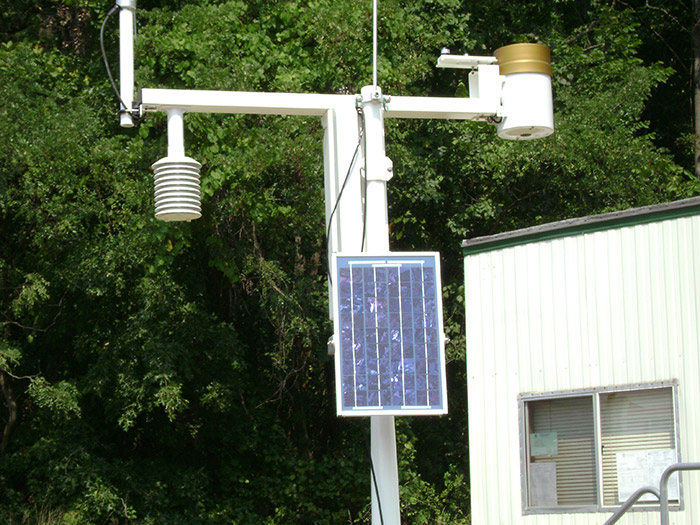
2.9.4 Soil Moisture
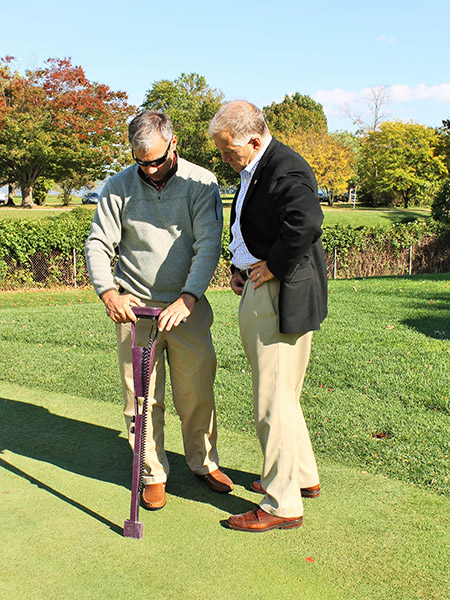
To accurately measure local precipitation, the proper use of rain gauges, rain shut-off devices, soil moisture sensors, and other irrigation management devices should be incorporated into the site’s irrigation schedule. Monitoring of soil moisture, in addition to calculating ET rates and visual observations of turf, assists in meeting turf water needs while conserving water resources.
2.9.5 Irrigation Scheduling
Proper irrigation can sustain plant energy reserves, increase root mass and depth, and reduce thatch accumulation. Irrigation should be applied as necessary to prevent wilt without oversaturating the soil/root zone and without compromising playing conditions. Soils do not need to be wetted below the root zone depth, as this could potentially lead to leaching, especially in shallow soils.
The goal of successful irrigation management is to limit excessive soil moisture while preventing wilt. Golf course managers strive to precisely apply water, so PAW is only slightly greater than predicted ET. For many highly maintained turf areas, like greens, small amounts of water are applied every night to replace what was lost the prior day. Soil moisture probes can help further improve irrigation precision. These technologies can guide irrigation head run times and identify locations that might benefit from additional hand watering.
During periods of sufficient natural precipitation, stress pre-conditioning with deficit irrigation can improve tolerance to future drought, heat, and cold stress. Deficit irrigation is the practice of limiting irrigation to slowly deplete soil PAW until the soil moisture approaches wilt points.
Computerized irrigation systems provide many advantages, including allowing a superintendent to remotely cancel the program if the course has received adequate rainfall. Clock-controlled irrigation systems preceded computer-controlled systems, and many are still in use today. Electric/mechanical time clocks cannot automatically adjust for changing ET rates. Therefore, frequent adjustment is necessary to compensate for the needs of individual turfgrass areas.
2.10 Irrigation Best Management Practices
Water Conservation and Efficient Use Planning
- Minimize acreage of irrigated turf.
- Convert out-of-play area turf to native plants, grasses, or ground covers to reduce water use and augment the site’s aesthetic appeal.
- During times of intense heat stress, syringing, or the practice of applying a small amount of water to help cool the turfgrasses as it evaporates, may be beneficial under certain conditions.
- Create a drought management plan for the facility that identifies steps to be taken to reduce irrigation/water use and to protect critical and valuable areas.
- Restrict water usage in time of drought. Use appropriate turfgrass species adapted to the location of the golf course and use drought-tolerant species whenever possible.
- Consider drought resistance when selecting turf species and varieties.
Irrigation Water Supply
- Identify appropriate water supply sources that meet seasonal and bulk water allocations for grow-in and routine maintenance needs.
- Use alternative water supplies/sources that are appropriate and sufficiently available to supplement water needs, if available.
- Reclaimed, effluent, and other non-potable water supply mains must have a thorough cross-connection and backflow prevention device in place that operates correctly.
- Post signs in accordance with local utility and state requirements when reclaimed water is in use.
- Use salt-tolerant varieties of turf and plants to mitigate saline conditions resulting from an alternative water source, if necessary.
- Assess the irrigation water quality.
- Account for the nutrients in irrigation water when making fertilizer calculations.
- Monitor irrigation water regularly for dissolved salt content.
- Conduct a seasonal bulk water requirement analysis and a maximum bulk water requirement analysis.
- Design and/or maintain a system to meet a site’s peak water requirements under normal conditions. Be flexible enough to adapt to various water demands and local restrictions.
- Install and maintain accurate metering systems.
Irrigation System Design
- Conduct a thorough site assessment prior to designing the irrigation system.
- Develop a written, site-specific Irrigation Management Plan.
- Seek assistance from irrigation professionals, such as from Certified Golf Course Irrigation System designers and WaterSense-certified irrigation consultants, and follow established BMPs related to system design.
- Sprinkler placement should avoid interfering with the playability of the hole.
- Irrigation pipes should be installed away from the green surface to avoid substantial increases in repairs and damages should pipe failures occur.
- Update multi-head control systems with single-head control systems to conserve water and to enhance efficiency.
- Manual quick-coupler valves should be installed for site specific irrigation, so hand-watering can be used during severe droughts.
- Install part-circle heads along lakes, ponds, wetlands margins, native areas, and tree trunks.
- Use part-circle or adjustable heads to avoid overspray of impervious areas such as roadways, sidewalks, and parking areas.
- Incorporate multiple nozzle configurations to add flexibility and enhance efficiency/distribution.
- When possible, use precise irrigation control technologies.
Irrigation System Installation
- The designer must approve any design changes before construction.
- Prior to construction, all underground cables, pipes, and other obstacles must be identified, and their locations flagged.
- Only qualified specialists should install the irrigation system.
- Construction and materials must meet existing standards and criteria.
- Construction must be consistent with the design.
- Installers must provide an accurate and comprehensive As-Built map.
Irrigation System Maintenance and Performance
- Visual inspections should be conducted to identify necessary repairs or corrective actions, which should be completed before further evaluation of system performance.
- Pressure and flow should be evaluated to determine that the correct nozzles are being used and that heads are performing according to the manufacturer’s specifications.
- Pressure and flow rates should be checked (ideally annually) at each head to determine the average precipitation rates.
- Catch-can tests should be run to determine the uniformity of coverage and to accurately determine irrigation run times.
- Catch-can testing should be conducted on the entire golf course to ensure that the system is operating at its highest efficiency.
- Conduct an irrigation audit annually to facilitate a high-quality maintenance and scheduling program for the irrigation system.
- Inspect for water distribution interferences, such as trees and other obstructions.
- Inspect for broken and misaligned heads.
- Check that the rain sensor is present and functioning.
- Inspect the backflow device to determine that it is in place and in good repair.
- Examine turf quality and plant health for indications of irrigation malfunction or a need for scheduling adjustments.
- Periodically conduct a professional irrigation audit that follows established guidelines.
- Record any modifications to the As-Built map, including head and nozzle choices.
- Use photography to record and document any major underground installations/repairs.
- Review efficiency of above-ground electric motors annually.
- Licensed professionals should routinely inspect the well housing.
Irrigation System Winterization
- Flush and drain above-ground irrigation system components that could hold water as part of winter preparation.
- Remove water from all conveyances and supply and distribution devices that may freeze. Use compressed air or open the drain valves at the lowest point on the system.
- Change filters, screens, and housing; remove drain plugs and ensure any water is removed from the system. Secure systems and close and lock covers/compartment doors to protect the system from vandalism and from animals seeking refuge.
- Drain any above-ground pump casings that may have trapped water.
- Record metering data before closing the system.
- Secure or lock any remote irrigation components, including satellites.
- Perform pump and engine servicing/repair before winterizing.
Irrigation System Spring Start-up
- Power up the pump station and pump motors before using the system. By completing this task ahead of recharging the system, the coils inside the motors heat up and will therefore remove any moisture that collected during the offseason.
- Keep the water pressure at 60 PSI or lower when priming the lines.
- Operate each of the sprinklers until all excess air is flushed from the irrigation system.
- Check the functionality of air pressure relief valves.
- Inspect the entire system for any corrective maintenance issues.
Irrigation Management Decisions
- Evaluate root zone depth on the course and do not irrigate beyond this depth.
- Monitor potential ET and calculate plant available water to improve irrigation precision.
- Utilize soil moisture technologies and techniques consistently.
- Use soil moisture sensors to assist in scheduling or to create on-demand irrigation schedules.
- Use multiple soil moisture sensors to reflect soil moisture levels.
- Place soil moisture sensors in a representative location within an irrigation zone.
- Use predictive models to estimate soil moisture and the best time to irrigate.
- Use a journal to record the “indicator zones” that should be more closely monitored.
- Calibrate older clock-control station timing devices periodically, and at least seasonally.
- Install control devices to allow for maximum system scheduling flexibility.
- Base plant-water needs should be determined by ET rates, recent rainfall, recent temperature extremes, and soil moisture.
- Avoid use of a global setting; adjust watering times per head.
- Adjust irrigation run times based on current local meteorological data and computed daily ET rate to meet the turf’s moisture needs.
- Manually adjust automated ET data to reflect wet and dry areas on the course.
- Irrigation quantities and rates should not exceed the available moisture storage in the root zone.
- Use infrequent, deep irrigation to supply sufficient water for plants and to encourage deep rooting in fairways and roughs.
- To maximize turf health during summer, irrigate to the depth of the turf root in early morning.
- Visually monitor for localized dry conditions or hot spots to identify poor irrigation efficiency or a failed system device.
- The irrigation schedule should coincide with other cultural practices (for example, the application of nutrients, herbicides, or other chemicals).
- Generally, granular fertilizer applications should receive 0.25” of irrigation to move the particles off the leaves while minimizing runoff.
- Lightly irrigate high value turf on dry, sunny winter days when the air temperatures are well above freezing to rehydrate plant crowns back to a survivable level and restore moisture at the surface.





